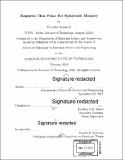Magnetic thin films For spintronic memory
Author(s)
Agrawal, Parnika
DownloadFull printable version (15.85Mb)
Other Contributors
Massachusetts Institute of Technology. Department of Materials Science and Engineering.
Advisor
Geoffrey S.D. Beach.
Terms of use
Metadata
Show full item recordAbstract
Domain walls are regions of spatially non-uniform magnetizations in magnetic materials. They form the boundaries between two or more uniformly magnetized regions called domains. Skyrmions are circular magnetic domains with chiral domain walls that are interesting due to their stability and potential for fast motion. These spin structures can be used to encode Os and Is in spintronic memory. Chiral domain walls and skyrmions have been seen in magnetic thin films sandwiched between non-identical non-magnetic materials which have high spin-orbit coupling and Dzyaloshinskii-Moriya interaction. An optimization of the different physical interactions involved in magnetic thin films can result in stripe and labyrinth domain patterns which can then be transformed into skyrmion lattices. In this thesis, we present a detailed understanding of single- and multi-layer magnetic thin films along with all the relevant physical interactions. We show that inplane magnetic fields stabilize domain walls in thin films with Dzyaloshinskii-Moriya interaction. The application of in-plane magnetic fields is shown to create multi-domain patterns in films where the ground state is uniform magnetization. Next, we study the formation of stripe and labyrinth domain patterns in magnetic films. The domain widths obtained are compared with the predictions of several theoretical models developed over the last 50 years. The appropriate model that works for thin films with strong Dzyaloshinskii-Moriya interaction is identified with the help of micromagnetic simulations. The appropriate model includes effects of finite domain wall width and volume charges inside Neel domain walls. This model is then used to measure the Dzyaloshinskii-Moriya interaction in experimentally grown magnetic thin films. Thereafter, we highlight the role of other design variables such as the thickness of magnetic and non-magnetic layers, the choice of materials, and the role of geometrical confinement in controlling the length scale of the domain patterns. This work generates the necessary knowledge and develops techniques to engineer chiral spin textures in single- and multi-layer magnetic thin films.
Description
Thesis: Ph. D., Massachusetts Institute of Technology, Department of Materials Science and Engineering, 2018. Cataloged from PDF version of thesis. Includes bibliographical references (pages 107-128).
Date issued
2018Department
Massachusetts Institute of Technology. Department of Materials Science and EngineeringPublisher
Massachusetts Institute of Technology
Keywords
Materials Science and Engineering.